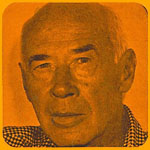
Net.art by Dr. Hugo Heyrman
a tribute to his work and life, books, art, loves & friends,
with an excellent collection of hard-to-find-Miller items
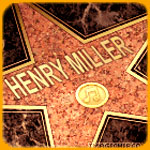
 |
Henry Miller Online Net.art by Dr. Hugo Heyrman a tribute to his work and life, books, art, loves & friends, with an excellent collection of hard-to-find-Miller items |
 |
LIFE |
| "I'm just a Brooklyn Boy. . ." | ||||
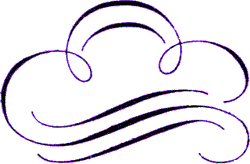 |
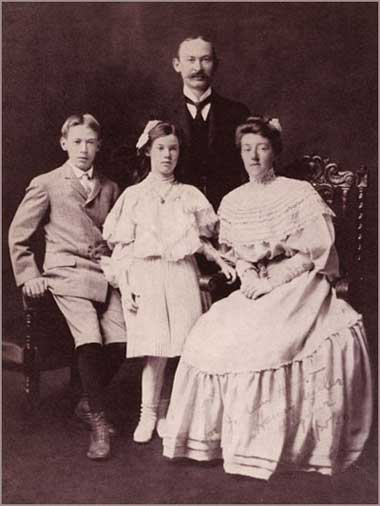 |
|||
Henry Valentine Miller was born to Heinrich Miller and Louise Nieting on Saturday, December 26, 1891 in Manhattan, New York City, 85th street, near the East River. His family moved to the Williamsburg section of Brooklyn, the 14th Ward and then finally to 'Decatur Street', a part of Brooklyn known as Bushwick, the place he would later refer to as "the street of early sorrows". Miller spent many years in Paris, where his autobiographical and sexually explicit novels Tropic of Cancer and Tropic of Capricorn were published in the 1930's. They were banned in the U.K. and the U.S. While in Paris he began a famous affair with writer Anaïs Nin. In 1940, Miller returned to New York, and spent the next four years searching for a place he could tolerate, finally settling in Big Sur, California. He wrote the trilogy known as 'The Rosy Crucifixion' (the novels Sexus, Plexus and Nexus). His early novels were finally published in the U.K. and the U.S. in the 1960's, and Miller became a pop culture icon. |
||||
Henry with his sister Loretta, his mother and father. |
||||
"This is Henry, Henry Miller from Brooklyn" |
||||
"From five to ten were the most important years of my life;" Miller said. "I lived in the street and acquired the typical American gangster spirit." |
||||
Henry Miller's work experience: a bellboy, garbage collector, cement mixer, gravedigger, employment manager at Western Union, employee at Park Department in Queens, manager of New York City speakeasy, and proofreader on the Paris edition of The Chicago Tribune. |
"I like Henry Miller. I think he's the greatest American writer." —Bob Dylan | |||
| Henry Miller and his family | ||||
 |
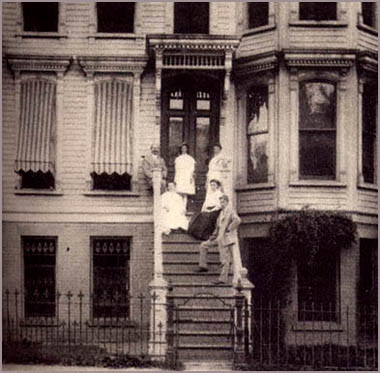 |
|||
1910, Henry Miller began an affair with his "first mistress", Pauline Chouteau of Phoebus, Virginia, a woman old enough to be his mother. Henry called her "the widow". In 1917, he married his first wife, Beatrice Sylvas Wickens from Brooklyn. She was a pretty young brunette who shared another of his passions, playing the piano. With Beatrice he had a daughter, Barbara. He had also a brief affair with his mother-in-law. |
||||
| Henry Miller and his family on 1063 Decatur Street, circa 1905 (Photo: credited to Masters and Masterworks/Robert Snyder) |
||||
Henry Miller maried five times |
||||
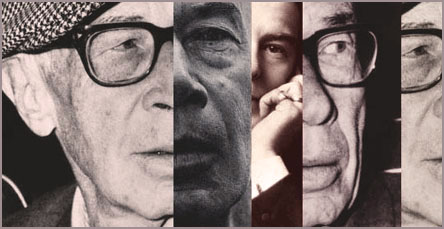 |
 |
|||
| Miller was married five times over the course of his life * * Beatrice Sylvas Wickens (a pianist), 1917 (divorced, 1924) * June Smith Mansfield, June 1, 1924 (divorced, 1934) * Janina Martha Lepska, December 18, 1944 (divorced, 1952) * Eve McClure (an artist), December 29, 1953 (divorced, 1962) * Hoki Tokuda (a jazz pianist and singer), September 10, 1967 (divorced, 1978) |
||||
| Children: Barbara (first marriage); Valentine and Tony (third marriage) | ||||
| Manhattan: Broadway - 46th Street - West (1920) | ||||
In 1923 Henry Miller was about to meet his most enduring muse, a dance girl named June Mansfield (called "Mona" or "Mara" in his novels). She was a dark, beautiful Jewish femme fatale. They met at a Times Square dance parlor 'Wilson', when she was 21 and he was 31. Disregarding the rules, he fell madly in love with her, divorced Beatrice in 1924, and married June. She encouraged him to quit his job and start putting his efforts into writing. "It must have been a Thursday night when I met her for the first time at the dance hall." —Henry Miller (Sexus) "Fell in love with June Edith Smith while she worked in a Broadway dance palace." —Henry Miller (My Life and Times) This marked the beginning of a tempestuous lifestyle in which he came to the brink of suicide, but also the time in which he was first free to give his full attention to writing. He quit his job, living off the money that June managed to get from other men. June fascinated Miller with her numerous intrigues with others, men and women alike. |
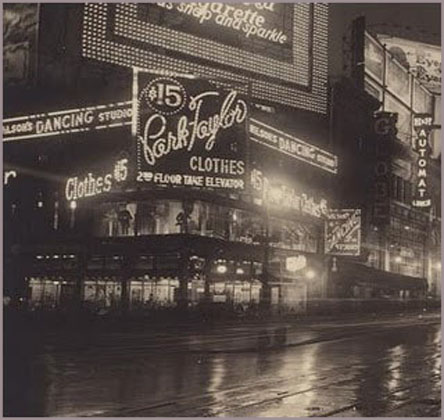 |
|||
Wilson's Dancing Studio, later became the 'Orpheum Dance Palace', |
||||
June S 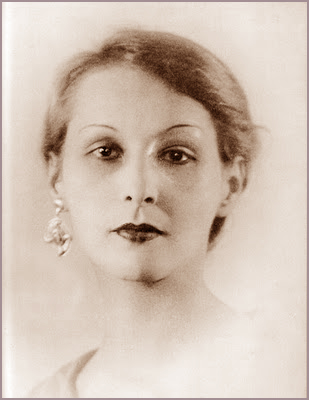 mith Mansfield Miller mith Mansfield Miller |
||||
| June Mansfield Miller (January 12, 1902 - February 1979) was the much written about and discussed second wife of Henry Miller. She was born in Bukovina, Austria-Hungary (of Romanian Gypsy origin as mentioned in Sexus) as Juliet Smerth, the daughter of Wilhelm and Frances Budd Smerth. She emigrated with her family to the United States and arrived there on July 10, 1907, aged five. She would reside in New York City for much of the rest of her life, excepting a tour of Europe and settling in Paris. | ||||
June Miller, photographed circa 1933 |
||||
| June (Mona-Mara) Mansfield Miller | ||||
| December 1931, Anaïs wrote the following passage shortly after meeting June for the first time: "A startingly white face, burning eyes. June Mansfield, Henry's wife. As she came towards me from the darkness of my garden into the light of the doorway I saw for the first time the most beautiful woman on earth. Years ago, when I tried to imagine a pure beauty, I had created an image in my mind of just that woman. I had even imagined she would be Jewish. I knew long ago the color of her skin, her profile, her teeth. Her beauty drowned me. As I sat in front of her I felt that I would do anything she asked of me. Henry faded, she was color, brilliance, strangeness. Her role in life alone preoccupies her. I knew the reason: her beauty brings dramas and events to her. Ideas mean little. I saw in her a caricature of the theatrical and dramatic personage. Costume, attitudes, talk. She is a superb actress. No more. I could not grasp her core. Everything Henry had said about her was true." |
 |
|||
Henry's second wife. In Tropic of Capricorn, June appears as 'Mara'. In The Rosy Crucifixion, June begins as 'Mara', but in the first volume of the series her name is changed to 'Mona'. In Tropic of Cancer she appears throughout as 'Mona'. |
||||
| June in Paris | ||||
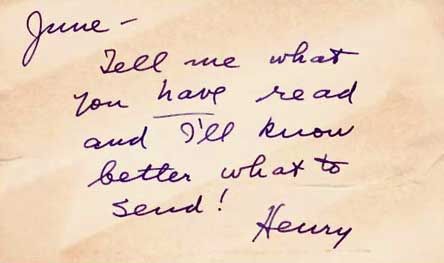 |
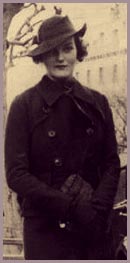 |
|||
Autograph Note, Signed. (Undated. A 5" x 3" card) "June -/ Tell me what/ you have read/ and I'll know/ better what to/ send!/ Henry." |
June Mansfield Miller | |||
Henry Miller in Paris, 1931 |
||||
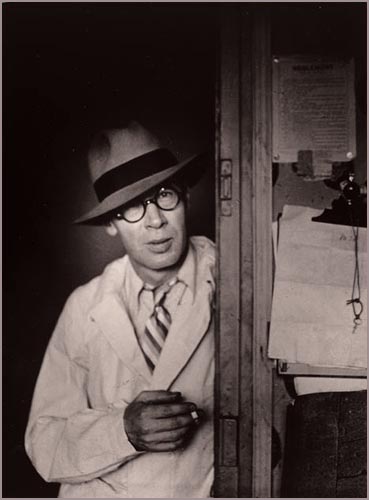 |
In 1930, determined to become a writer, Miller went to Paris alone, where he remained for nearly ten years with very little money. It was only there that Henry Miller would find his voice to become 'Henry Miller'. "Paris is simply an obstetrical instrument that tears the living embryo from the womb and puts it in the incubator", he wrote. Miller found himself surrounded by artists, philosophers, musicians and poets. The outrageously well-read Miller was suddenly in the company of others who'd also read Rabelais and Blake. And of course there were the women, too. Everything he saw was an inspiration, everything brought the words flowing. He had no money, of course, but that didn't concern him. As he wrote in 'Tropic of Cancer' most famous passage: "I have no money, no resources, no hopes, I am the happiest man alive." "Paris is like a whore. From a distance she seems ravishing, you can't wait until you have her in your arms. And five minutes later you feel empty, disgusted with yourself. You feel tricked. I return to Paris with money in my pocket‚ a few hundred francs, which Collins had shoved in my pocket just as I was boarding the train." —Henry Miller (Tropic of Cancer) While in Paris, Henry Miller also befriended a woman who was to be his long time lover and occasional benefactor Anaïs Nin. Their relationship is ironically documented by Nin rather than Miller. Nin's diaries are filled with social engagements, their love affair and a love affair with Miller's wife, June. These stories were made famous in the film 'Henry & June' from 1992 (June was portrayed by Uma Thurman). |
|||
| Henry Miller, as he appeared at the hotel room of Brassaï, L’hôtel des Terrasses in Paris 1931. The two close friends enjoyed each other's company thoroughly. Photographed by Brassaï (Gyula Halász) | "There are many photographs which are full of life but which are confusing and difficult to remember. It is the force of an image which matters." —Brassaï | |||
| Henry Miller with Janina Martha Lepska | ||||

|
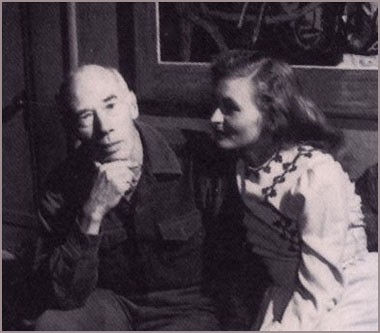 |
|||
| When World War II broke out, Miller returned to the U.S. Shortly after he settled at Big Sur in December 1944, Miller married his third wife, Janina Martha Lepska, who had come from Poland with her family some years before. Her brilliant mind made an impression on him, but he was attracted even more to her blonde Slavic good looks. She was a young philosophy student, who was over 30 years his junior, and by whom he had two children, a daughter, Valentin, and a son, Tony. The marriage ended seven years later in 1951. |
||||
"I live all alone like a monk, a celibate, an exile", Miller wrote to his old friend Brassaï. |
||||
| Henry and Eve | ||||
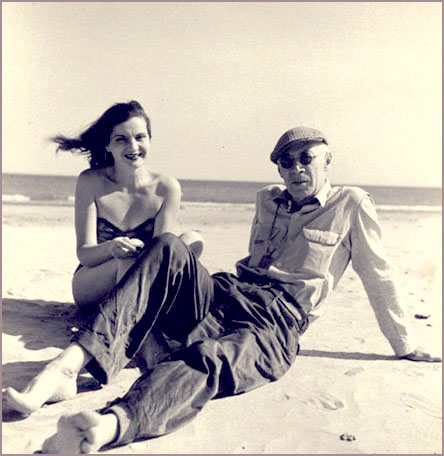 |
||||
| Henry Miller and Eve McClure Photo: Denise Bellon, 1948 (vintage gelatin silver print) |
||||
| Henry Miller with Eve McClure | ||||
| "The art of living is based on rhythm - on give and take, ebb and flow, light and dark, life and death. By acceptance of all the aspects of life, good and bad, right and wrong, yours and mine, the static, defensive life, which is what most people are cursed with, is converted into a dance, 'the dance of life.' The real function of the dance is metamorphosis." —Henry Miller While living in Big Sur, Miller married two more of his eventual five wives, Janina Martha Lepska, with who he had one daughter Barbara, and in 1953 Eve McClure. With his two children, Tony and Valentine, Miller lived on Partington Ridge (also known as Anderson's Point). The house was on a plateau two thousand feet above the Pacific Ocean: "About fifty feet from the house, the land simply ended, and it was an abrupt decent to the sea far below." At this place in Miller's life he finished the work that immortalized Big Sur in the world of literature, Big Sur and the Oranges of Hieronymus Bosch. |
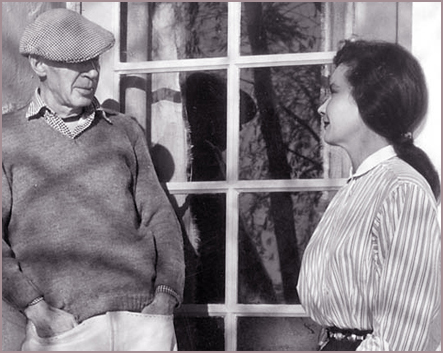 |
|||
| Announcement of Miller's marriage to Eve McClure. Married. Henry Miller, 62, and Evelyn Byrd McClure, 29, Hollywood artist-actress; each for the third time; in Carmel Highlands, California. (Source: Time Magazine, January 11, 1954.) |
Henry Miller with his fourth wife Eve McClure (an actress and artist) in Big Sur in the summertime. Photo: Harry Redl, 1960 (Source: The San Francisco Chronicle, April 22, 2007.) |
|||
Hiroko 'Hoki' Tokuda Miller |
||||
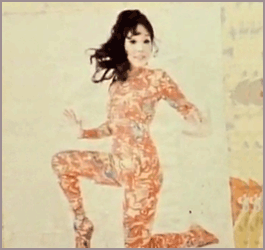 |
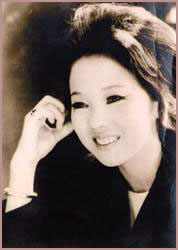 |
Henry Miller had always been facinated by the whole notion of the Geisha and dreamed of having a perfect Geisha for a wife. . . The ideal image of the devoted Oriental woman shimmered in his mind. Henry Miller met Japanese jazz singer Hiroko (Hoki) Tokuda at a Hollywood bar when she had just arrived from Japan and she became his fifth wife in 1967. Miller was 75 at the time and Hoki was 27. |
||
During this part of his life Henry Miller was in his "Japanese phase". |
||||
| Henry & Hoki, after the wedding in Beverly Hills | ||||
Hoki Tokuda was an attractive woman who was a cheesy lounge singer & wannabe actress working at a Los Angeles Japanese restaurant. Miller fell in love with some image he concocted & Hoki saw him for the patsy he was. All this woman did was tease & lead on Miller. He bought her a new white Jaguar that she quickly smashed up. Miller kept tossing money at her, and even went to Japan with her to try to use his fame there to promote Hoki. They separated in 1970 and finally divorced in 1977. Hoki Tokuda moved to Marina del Rey and opened her boutique shop in Beverly Hills, and then a bar in Los Angeles. Hoki returned to Japan in the mid-'80s, and opened another bar called "Tropic of Cancer" in Roppongi, Japan. |
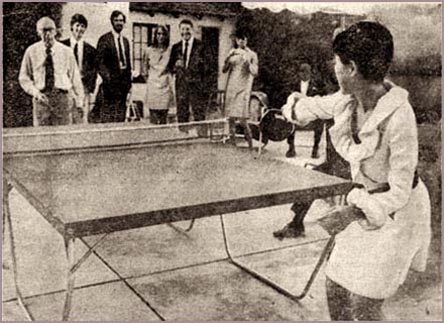 |
|||
| It was a fast game of table tennis that led to the romance, explained author Henry Miller, 75, after he maried his fifth, Hoki Tokuda, 27, on september 10 1967.
And yesterday, after the wedding in Beverly Hills, they where back at the table for more tennis. (Source: New York Post, Monday, September 11, 1967) |
||||
Henry Miller in Paris, 1969 |
||||
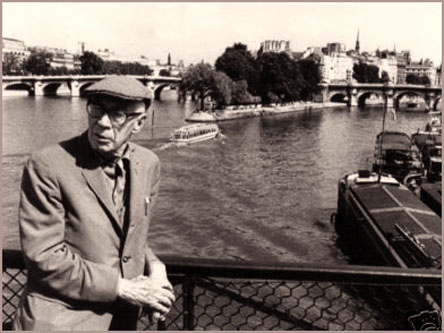 |
"Going back in a flash over the women I've known. It's like a chain which I've forged out of my own misery. Each one bound to the other." —Henry Miller (Tropic of Cancer) "No appointments, no invitations for dinner, no program, no dough. The golden period, when I had not a single friend. —Henry Miller (Tropic of Cancer) ". . . I experience once again the splendor of those miserable days when I first arrived in Paris, a bewildered, poverty-stricken individual who haunted the streets like a ghost at a banquet." —Henry Miller (Tropic of Cancer) ". . . Everything comes back to me in a rush —the toilets that wouldn't work, the prince who shined my shoes, the Cinema Splendide where I slept on the patron's overcoat, the bars in the window, the feeling of suffocation, the fat cockroaches, the drinking and carousing that went on between times, Rose Cannaque and Naples dying in the sunlight." —Henry Miller (Tropic of Cancer) |
|||
| View from Big Sur, California | ||||
In 1940, Henry Miller returned to the United States, settling in Big Sur, California, and continued to produce vividly written works that challenged contemporary American cultural values and moral attitudes. Miller fell in love with the rugged, isolated region, on his first visit in 1944, and decided to move there almost immediately. Upon his arrival in Big Sur, Miller wrote, "Here I will find peace. Here I shall find the strength to do the work I was made to do." He also became part of a literary and artistic community that included Emil White, Jaime de Angulo, Lillian Bos Ross and her husband Harrydick Ross, Ephraim Doner, and others. His first home on the coast was in the Log House, above Nepenthe near Anderson Creek (from May 1944 until January 1946). Within four years of his arrival, royalties from overseas enabled him to live comfortably in Big Sur, even providing him with the resources to purchase a house on Partington Ridge. |
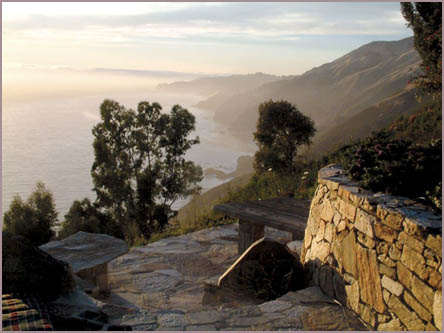 |
|||
| When he first moved to Big Sur, Miller was struggling to make ends meet. | Henry Miller lived in Big Sur from 1944-1962. | |||
The Road to Henry |
||||
 |
 |
|||
| "Artists never thrive in colonies. Ants do." —Henry Miller | ||||
The road up to Henry Miller's house on Partington Ridge. (Photo: Magnus Torén) |
||||
| Miller at Big Sur | ||||
 |
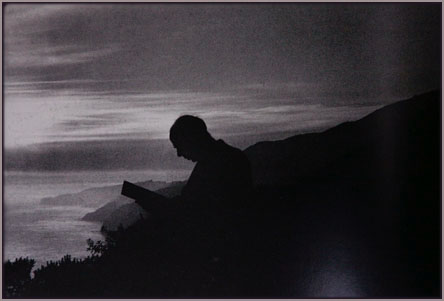 |
|||
Henry Miller helped make Big Sur famous in the 1940s and '50s, turning out novels that challenged literary norms, plus thousands of watercolor paintings. Miller was well established before he found Big Sur in 1942. |
||||
| Henri Cartier-Bresson's portrait of Henry Miller on the cliffs of Big Sur. | ||||
Henry Miller's Children, Valentine and Tony |
||||
|
Henry Miller with his third wife, Janina Martha Lepska, raised his two childeren Valentine and Tony, now aged eighteen and fifteen respectively, in his cramped home on Partington Ridge and had these words to say about watching them grow up here: ". . . They had skies of pure azure and walls of fog moving in and out of the canyons with invisible feet, hills in winter of emerald green and in summer mountain upon mountain of pure gold. They had even more, for there was ever the unfathomable silence of the forest, the blazing immensity of the Pacific, days drenched with sun and nights spangled with stars. . ." |
|||
Valentine Miller and Tony Miller, standing on a bluff and look at the Pacific Ocean from Big Sur, California, July 1959. (Photo: J. R. Eyerman/Time & Life Pictures/Getty Images, July 01, 1959) |
||||
| Henry Miller, Big Sur 1961 | ||||
Henry Miller came to see Big Sur as the first real home he had ever known.
Creatively, he flourished, finding everything his spirit needed in the friendship of the community and the brilliant light and beauty of this road less traveled. Living in Big Sur obviously had a profound effect on Miller, inspiring him to write: "Peace and solitude! I have had a taste of it, even here in America." The Big Sur landscape gave him "such a feeling of contentment, such a feeling of gratitude was mine that instinctively my hand went up in benediction. Blessings! Blessings on you, one and all! I blessed the trees, the birds, the dogs, the cats, I blessed the flowers, the pomegranates, the thorny cactus, I blessed men and women everywhere, no matter on what side of the fence they happened to be." |
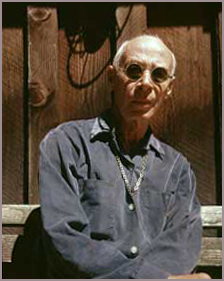 |
|||
Photograph: Jonathan Williams |
||||
Henry Miller playing Ping-Pong with a naked Lady |
||||
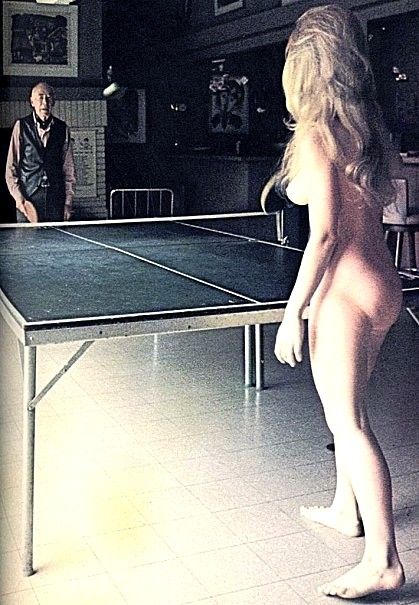 |
"I keep the Ping-Pong table handy for people I don’t want to talk to. You know, it’s simple. I just play Ping-Pong with them." —Henry Miller "This is my seventieth year of ping-pong playing," Henry Miller wrote in 1971. "I started at the age of 10 on the dining room table. I take on players from all over the world. I play a steady, defensive Zen-like game. The importance of my recreation lies in preventing intellectual discussions. No matter how important or glamorous an opponent may be, I never let him or her distract me." And they were often glamorous and distracting. Miller played ping-pong at Clichy with Anaïs Nin, with Chaim Soutine at the Villa Seurat, with Lawrence Durrell in Corfu, at a Paris bistro with Brassaï, in Hollywood with Man Ray. . . |
|||
Henry Miller called Ping-Pong “a game of endless fascination.” |
||||
| Henry Miller 'Asleep & Awake' in his bathroom with Gurdjieff |
||||
Filmed when the author was 81, "Henry Miller Asleep & Awake" is a voyage of ideas about life, writing, sex, spirituality, nightmares, and New York that captures the warmth, vigor and high animal spirits of a singular American artist. The man is Henry Miller and the room is his bathroom. It's a miraculous shrine covered with photos and drawings collected by the author over the course of his long and fruitful life. Graciously, in his raspy, sonorous voice, he points out the highlights of his improvised gallery, speaking of philosophers, writers, painters, mad kings, women, and friends. |
||||
Henry Miller's home in Pacific Palisades |
||||
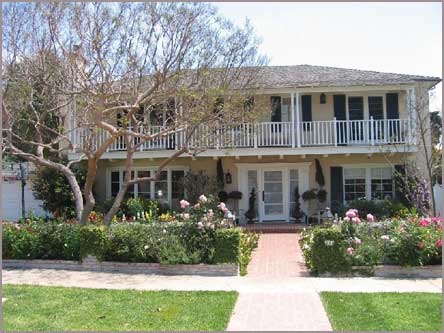 |
"(My) ideal is to be free of ideals, free of principles, free of isms and ideologies. I want to take to the ocean of life like a fish takes to the sea." —Henry Miller (On Turning Eighty) Henry Miller's book, 'Big Sur and the Oranges of Hieronymus Bosch', recounts how he fell in love with this country in Northern California. Most of his life Miller had lived without regular income, but when his books started sell, he bought a house on Ocampo Drive 444 in the Pacific Palisades, which looked like it belonged to a movie star. It had a heated swimming pool in which Miller swam daily. For a number of years Twinka Thiebaud, daughter of California painter Wayne Thiebaud lived with the aging novelist Henry Miller in his Pacific Palisades home. Twinka helped take care of Henry in the end of his life. She was friends with his daughter, and also edited a book of Miller's miscellanea titled "Reflections." |
|||
Henry Miller spent the last years of his life at his home in 444 Ocampo Drive, Pacific Palisades, Los Angeles, California. Henry Miller died in the summer, on June 7, 1980, having influenced an entire generation of writers around the world. |
"Love is the most important theme in my life because it has provided me with almost all my creative fuel." —Henry Miller (Reflections) |
|||
| 444 Ocampo Drive, Pacific Palisades, Los Angeles | ||||
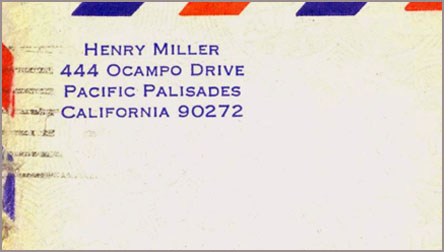 |
 |
|||
Henry Miller & Film |
||||
| Henry Miller was portrayed by Fred Ward in the 1990 movie 'Henry & June', and by Rip Torn in the 1970 film adaptation of 'Tropic of Cancer'. In the 1970 Jens Jørgen Thorsen adaptation of 'Quiet Days in Clichy', the Miller-based character of 'Joey' was played by the late Paul Valjean. Claude Chabrol's 1990 adaptation of the same novel saw Andrew McCarthy play the Miller role as 'Henry Miller' himself. Miller was also featured in the documentary 'Henry Miller Is Not Dead' that featured music by Laurie Anderson. Before his death, Miller filmed with Warren Beatty for his film 'Reds'. He spoke of his remembrances of John Reed and Louise Bryant as part of a series of 'witnesses'. The film was released eighteen months after Miller's death. |
||||
In 1960, Henry Miller was a member of the jury at the Cannes Film Festival. The writer Simenon was that year's jury president. |
||||
| Henry Miller's Archives | ||||
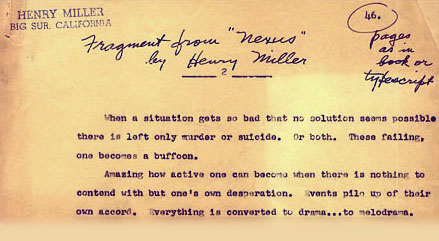 |
Henry Miller's papers were donated to the UCLA Young Research Library Department of Special Collections. The 'Henry Miller Art Museum' at Coast Gallery in Big Sur, the Harry Ransom Humanities Research Center at the University of Texas at Austin, and UCLA all hold a selection of Miller's watercolors, as did The 'Henry Miller Museum of Art' in Omachi City in Nagano, Japan (before closing in 2003). A portion of the correspondence between the Grove Press and Henry Miller are currently housed in the Special Collections Research Center at Syracuse University. Special Collections at the University of Victoria holds a significant collection of Miller's manuscripts and correspondences, including the corrected typescript for Max and 'Quiet Days in Clichy', as well as Miller's lengthy correspondence with Alfred Perlès. |
|||
Rue Henry Miller |
||||
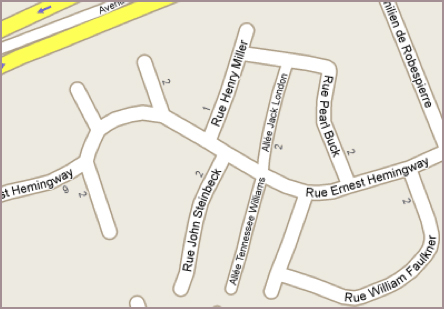 |
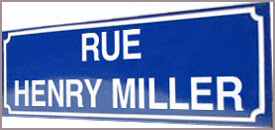 |
|||
| There is a street in Paris named after Henry Miller. The street can be found nearby in the suburb of Créteil, nested amid a warren of residential streets named for American authors. Rue Ernest Hemingway traces the main artery of the neighborhood, which branches off into streets bearing the names of Henry Miller, John Steinbeck, Jack London, Tennessee Williams, Pearl Buck and William Faulkner. | ||||
| Henry Miller Avenue | ||||
 |
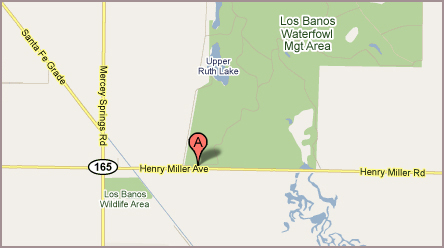 |
|||
Other Henry Miller places are: Henry Miller Road, CA, United States Rue Henry Miller, Thiais, France Henry Miller Road, Gustine, CA, United States |
||||
| Henry Miller Ave, Los Banos, CA, United States | ||||
LIFE |
| ( ( ( museums of the mind ) ) ) |